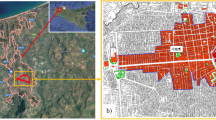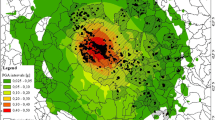Abstract
The European Commission funded the RISK-UE project in 1999 with the aim of providing an advanced approach to earthquake risk scenarios for European towns and regions. In the framework of Risk-UE project, two methods were proposed, originally derived and calibrated by the authors, for the vulnerability assessment of current buildings and for the evaluation of earthquake risk scenarios: a macroseismic model, to be used with macroseismic intensity hazard maps, and a mechanical based model, to be applied when the hazard is provided in terms of peak ground accelerations and spectral values. The vulnerability of the buildings is defined by vulnerability curves, within the macroseismic method, and in terms of capacity curves, within the mechanical method. In this paper, the development of both vulnerability and capacity curves is presented with reference to an assumed typological classification system; moreover, their cross-validation is presented. The parameters of the two methods and the steps for their operative implementation are provided in the paper.
Similar content being viewed by others
References
ATC13 (1987) Earthquake damage evaluation data for California. Applied Technology Council, Federal Emergency Management (FEMA), Redwood City, CA
Balbi A, Giovinazzi S, Lagomarsino S (2004) A vulnerability method for historical centre buildings. In: Proc. 11th Italian conference on Earthquake engineering, Genoa, Italy
Benedetti D, Petrini V (1984) On seismic vulnerability of masonry buildings: proposal of an evaluation procedure. L’industria delle costruzioni 18:66–78 (in Italian)
Braga F, Dolce M, Liberatore D (1982) A statistical study on damaged buildings and an ensuing review of the M.S.K76 scale. In: Proc. 7th European Conference on Earthquake Engineering, Athens
Bramerini F, Di Pasquale G, Orsini A, Pugliese A, Romeo R, Sabetta F (1995) Seismic risk for the Italian territory. Proposal for a methodology and preliminary results. Technical report from Servizio Sismico Nazionale SSN/RT/95/01, Rome (in Italian)
Cattari S, Curti E, Giovinazzi S, Lagomarsino S, Parodi S, Penna A (2004) A mechanical model for the vulnerability assessment and damage scenario of masonry buildings at urban scale. In: Proc. 11th Italian conference on earthquake engineering. Genoa, Italy
CEN (2003) Eurocode 8: design of structures for earthquake resistance—part 1: general rules, seismic actions and rules for buildings. European Committee For Standardisation (CEN), Brussels
Chopra AK, Goel RK (1999) Capacity-demand-diagram methods based on inelastic spectrum. Earthq Spectra, 15(4):637–656
Coburn A, Spence R (1992) Earthquake protection. Wiley Ltd., Chichester, England, ISBN 0 471 91833 4
Dolce M, Zuccaro G, Kappos A, Coburn A (1994) Report of the EAEE Working Group 3: Vulnerability and risk analysis. In: Proc. 10th European conference on earthquake engineering, vol. 4. Vienna, pp 3049–3077
Dubois D, Parade H (1980) Fuzzy sets and systems. Academic Press, New York
Fajfar P (2000) A non linear analysis method for performance-based seismic design. Earthq Spectra, 16(3):573–591
Freeman SA (1998) The Capacity Spectrum Method. In: Proc. 11th European conference on earthquake engineering. Paris
Freeman SA (2004) Why properly code designed and constructed buildings have survived major earthquakes. In: Proc. 13th world conference on earthquake engineering. Vancouver, Canada (CD-Rom)
Giovinazzi S, Lagomarsino S (2001) A methodology for the seismic vulnerability analysis of buildings. In: Proc. 10th Italian conference on earthquake engineering. Potenza, Italy (in Italian)
Giovinazzi S, Lagomarsino S (2002) A methodology for the vulnerability analysis of Built-up Areas. In: Lungu D, Wenzel F, Mouroux P, Tojo I (eds) Proc. of the international conference on earthquake loss estimation and risk reduction, vol. 2. Bucharest, Romania, pp 3–18, ISBN 973-85112–9-1
Giovinazzi S, Lagomarsino S (2003) Seismic Risk Analysis: a method for the vulnerability assessment of built-up areas. In: Balkema, AA. (eds) Eur safety and reliability conference ESREL. vol.18 Maastricht, The Netherlands, London (UK), ISBN 90 5809 595 9, pp 671–679
Giovinazzi S, Lagomarsino S (2004) A macroseismic model for the vulnerability assessment of buildings. In: Proc. 13th world conference on earthquake engineering. Vancouver, Canada, paper 896 (CD-Rom)
Giovinazzi S, Lagomarsino S (2005). Fuzzy-random approach for a seismic vulnerability model. In: Proc. ICOSSAR2005 safety and reliability of engineering systems and structures. Rome, Italy, Millpress, Rotterdam, ISBN 90 5966 040 0, pp 2879–2887
Giovinazzi S (2005). The vulnerability assessment and the damage scenario in seismic risk analysis. Ph.D Thesis of the doctoral course “Risk Management on the built environment” jointly organized by University of Florence (I) and TU-Braunschweig (D)
Goel RK, Chopra AK (1997) Period formulas for moment-resisting frame buildings. J struct Eng-ASCE, 123(11):1454–1461
Grunthal G (1998) European Macroseismic Scale. Chaiers du Centre Européen de Géodynamique et de Séismologie, vol. 15 Luxembourg
HAZUS (1999) Earthquake loss estimation methodology—technical and user manuals, vol. 1–3. Federal Emergency Management Agency (FEMA), National Institute of Building Sciences, Washington, DC
Kircher CA, Nassar AA, Kuster O, Holmes WT (1997) Development of building damage functions for earthquake loss estimation. Earthq Spectra, 13(4):663–682
Lagomarsino S (2006) Vulnerability assessment of historical buildings. In: Goula X, Oliveira CS, Roca A (eds) Assessing and Managing Earthquake Risk, ISBN 1-4020-3524-1
parameters. Bulletin Seismological Soci Am 67:877–915
Mouroux P, Bertrand E, Bour M, Le Brun B, Depinois S, Masure P (2004) The European RISK-UE project: an advanced approach to earthquake risk scenarios. In: Proc. of the 13th world conference on earthquake engineering. Vancouver, BC, Canada, paper 3329 (CD-Rom)
Ross TJ (1995) Fuzzy logic with engineering applications. McGraw Hill, New York, ISBN 0 07 0539170
Vidic T, Fajfar P, Fischinger M (1994) Consistent inelastic design spectra: strength and displacement. Earthq Eng Struct Dyn 23:507–521
Author information
Authors and Affiliations
Corresponding author
Rights and permissions
About this article
Cite this article
Lagomarsino, S., Giovinazzi, S. Macroseismic and mechanical models for the vulnerability and damage assessment of current buildings. Bull Earthquake Eng 4, 415–443 (2006). https://doi.org/10.1007/s10518-006-9024-z
Received:
Accepted:
Published:
Issue Date:
DOI: https://doi.org/10.1007/s10518-006-9024-z




